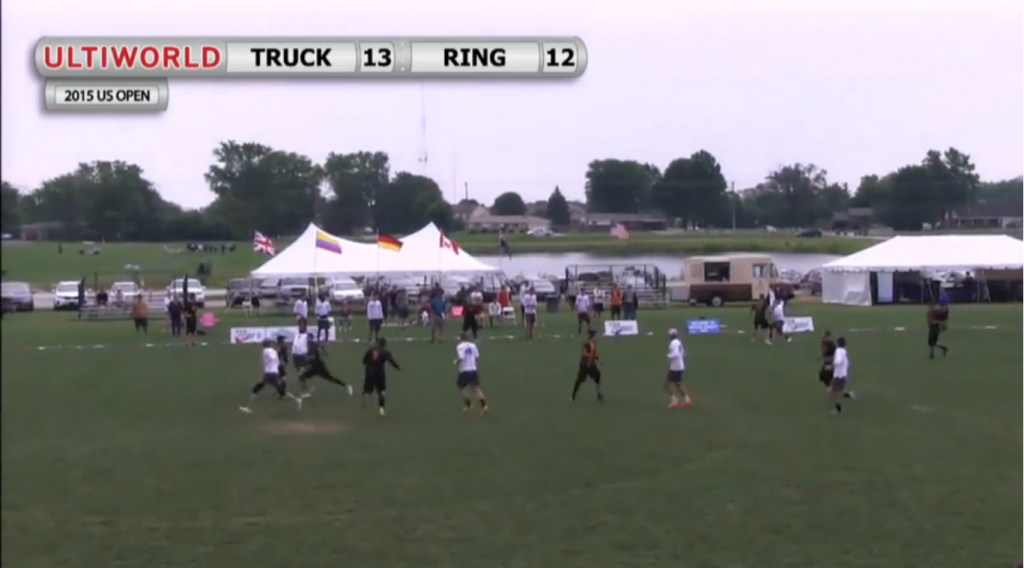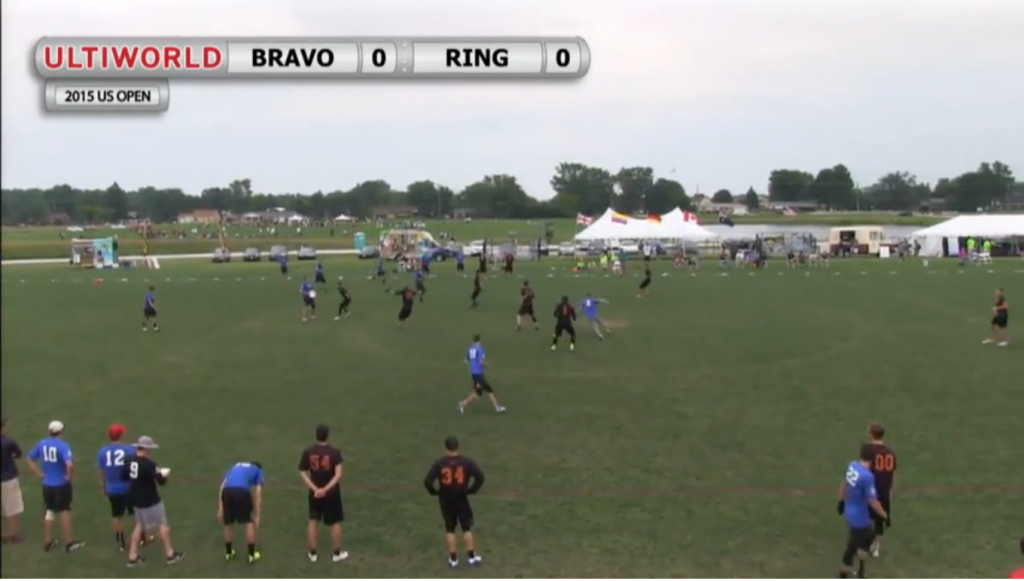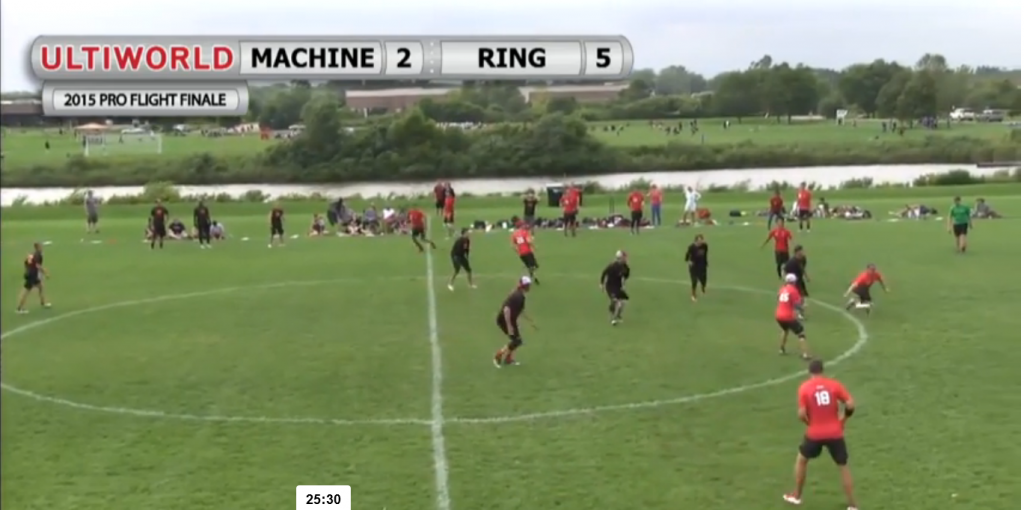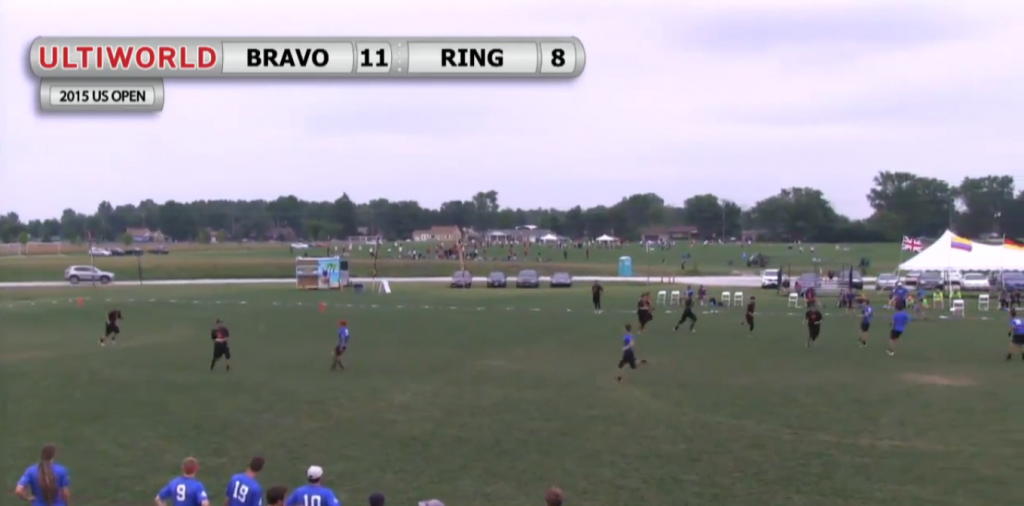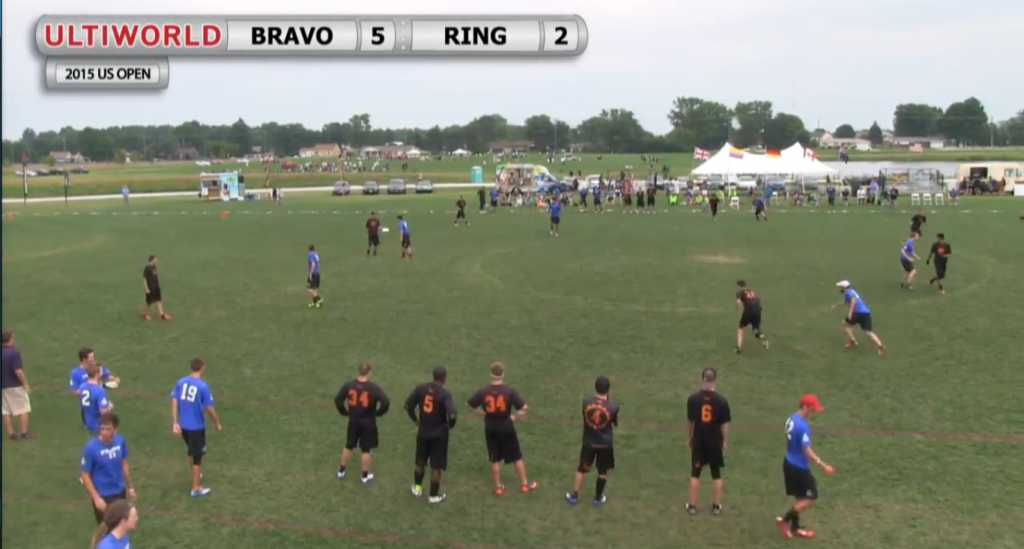Raleigh Ring of Fire has been inconsistent this season, but few doubt that they have the talent to compete deep into Nationals. Our video breakdown of their defense shows why Ring is such a dangerous opponent in bracket play, even if consistency remains a question mark.
September 30, 2015 by Kevin Herrera and Jesse Goldstein in Analysis with 0 comments
Last year, Ring of Fire blazed out of nowhere, taking advantage of a Nationals format that rewards winning in bracket play above all else, and took eventual silver medalist Boston Ironside to the wire in what many considered to be the game of the tournament. Serenaded by a chorus of boos belted with varying levels of sincerity from teammates and spectators alike, Ring’s fiery style conjured up several highlight-reel blocks and receptions, rallying from an 11-6 deficit to tie the game at 11 .
Ring ultimately fell on double game point, a disappointing end, to be sure, but far exceeding any expectations for Raleigh coming in. Ring truly peaked at the right time, with coach Mike DeNardis noting that in the semi-finals their defense was “the best they’ve played all season.”
While excitement over Ring’s success in 2014 was certainly justified, expectations for the 2015 campaign have reached a fever pitch. The team’s best feeder program, University of North Carolina Darkside, just won a college national title; Jon Nethercutt, college ultimate’s MVP, has shown flashes of brilliance as a featured Ring handler on offense. The bulk of Ring’s roster gelled with AUDL South Division champion Raleigh Flyers and the team was able to coax club stalwart Jared Inselmann out of retirement.
But Ring has been inconsistent this summer; what can we really expect from them at Nationals? Regular season footage available through Ultiworld’s video subscription service gives us a couple of hints into what might make the difference for Ring, and what might hold them back.
No Surprise: Defense Will Drive Ring
North Carolina’s calling card has always been aggressive, physical defense. That element of Ring keeps them in games even if their offense isn’t clicking. Expect three constants from the Raleigh D-line in Frisco:
- Small distances between marks and defenders
- Consistent harassment of the nearest reset
- Bodies flying all over the place when opposing offenses take shots down the field
The explosion of ultimate footage has brought about is the ability to see tendencies certain teams have when compared to others1; one example is the physicality of Ring’s defense.
The ultimate community talks a lot about how much contact North Carolina players create as they match up, and it usually revolves around whether there’s too much contact for it to be considered within the rules. Setting that aside for a moment, though, it’s important to appreciate that you have to be very tight to your matchup to touch them that much. Seeing Ring’s defense set up on stoppages really highlights this — the throwing lanes are tiny:
gfycat.com/ShowyImpressionableElk
Every opposing player has to fight to create any separation for their initial cut against Ring. A defender may get burned now and then because of the aggressive style, but Raleigh rarely fails to fulfill one of the basic aims of any defensive player: to make their opponent uncomfortable.
Watch Ring play defense for an extended period of time and it becomes very clear why they’re a team prone to closing the gap or running away with games in the second half: playing good offense for an entire game looks exhausting.
In addition to the smaller spaces to throw to as Ring plays tight man, resets that would normally come easy often see more pressure than a player expects. Terrence Mitchell, a rising star and great example of the Triangle Area’s talent pipeline of youth, does a great job of making his mark know he’s there.
gfycat.com/GiftedJointBluefintuna
There’s not much nuance to the third impressive quality Ring’s defense brings to the table: defenders are willing to throw their bodies around. What sets Raleigh’s willingness to bid apart, though, is that there seems to be a willingness to layout across the board on their defensive line. Watch them for more than a few points, and you’re almost guaranteed to see either a block or a drop created by someone flying around:
gfycat.com/HarmlessAltruisticGannet
gfycat.com/PersonalImaginativeBaboon
It would be silly to overanalyze these plays, but I do think we sometimes take for granted that all high-level teams create some appreciable number of diving blocks each game — which is simply not the case. At a tournament like Nationals, where offensive precision creates razor-thin margins for error, a defender’s ability to cover extra distance just a little bit faster can mean the difference between a one-goal win and a one-goal loss. Don’t be surprised to see Ring win a close game or two because a member of their D-line throws himself past a worn-down opponent during crunch time.
The Challenge: Putting Together Talent
While there’s no denying that Ring an embarrassment of talent on their roster, another fact is painfully obvious: this is a weird bunch.
Justin Allen is a high-flying sparkplug with a big flick pull and a tendency toward throwing truly bizarre stuff. Inselmann and Nethercutt are rock-solid handlers, both with proven ability to guide their teams to wins in high-stakes situations. Mark Lin is a young commodity who showed a lot of promise against stiff competition in the regular season. Dan Kantor is an excellent defender who has been spending most of his time of on offense lately. Hunter Taylor appears to be some kind of human cannonball.
There is no doubt that this is a team you could win with. Still, Ring’s challenge is going to be finding the right combinations and cohesiveness within a group of players whose skills require exceptional awareness from their teammates.
Nethercutt demonstrated his dominance for UNC Darkside as the best thrower on the field, but this usually found him operating as quarterback with teammates who knew that if they created a little bit of space, he’d find them. This year for Ring, Nethercutt hasn’t been quite so overwhelming, likely because he’s facing better defenders and has less space to throw into. Occasionally, he’s looked great, showing poise and taking tough, but smart throws to march Raleigh down the field:
gfycat.com/GlossyNeedyFirebelliedtoad
Other times, he’s found himself hanging on a bit too long in a division where faster movement and new throwing angles are essential to success on offense:
gfycat.com/BasicHandmadeAmericanbulldog
Taylor Pope is another question mark. He’s a big body and capable producing throws like this one, likely the shot of the tournament at the windblown Pro Flight Finale:
gfycat.com/TintedImpishAustralianfreshwatercrocodile
Unfortunately, he also appears to have lost a step or two since his time as a Ring centerpiece, and is approaching certifiable liability status on defense. Watch Machine’s Andrew Sheehan smell blood as Machine tries to work small passes for an upwind goal:
It’s worth nothing that this didn’t actually end in a score, and maybe Pope is smart enough as a veteran to pick his battles when chasing quicker players. Even so, one can imagine squirrely handlers — say throw-and-go enthusiasts on Rhino, Ring’s second round opponent — looking to pick on any perceived matchup advantage they can find.
Pope is only one example of several players on Raleigh’s roster that will present line-callers with tough choices in terms of when certain strengths like throwing skill, athleticism, or experience outweigh weaknesses in other areas, especially decision-making. Every team faces similar challenges, but the volatility that makes the Ring formula so dangerous is the same quality that will make their roster an especially tough group to manage effectively.
Some bonus personnel storylines to watch in Frisco:
- He’s had killer seasons in the AUDL and a fun Callahan video, but is this Justin Allen’s coming out party in the Club division?
- With questions surrounding back injuries hampering his play for a few seasons, can Ken Porter, once one of the most fearsome athletes in the game, still take over for Ring?
- Are Inselmann’s prior seasons enough to facilitate the chemistry he’ll need to contribute consistently to the team’s offense for just Nationals?
- David Richardson was tremendous in the AUDL; is he ready to perform against better competition?
- Not a question, but Dennis Tarasi has been giving Ring and the Flyers quality points all year. Keep an eye out for him as a big contributor moving the disc with smart throws and the ability to get open in small spaces a la Josh “Cricket” Markette.
Does Ring’s Aggressiveness Hold Up When It Counts?
For my money, this is the million dollar question. Every other box is checked, as Ring has the talent, fire, skills, and experience to take home a title. What the team always seems to lack is that level of composure that makes all of those Revolver and Ironside wins seem so effortless.2 Ring’s decision-making in their 2015 regular season has not been reassuring on this point. In games against Truck Stop and Johnny Bravo this season, the team needed come back heroics because of first halves full of plays like these:
gfycat.com/RegalArtisticBlackandtancoonhound
gfycat.com/VagueEasygoingIndianrockpython
Last year’s Ironside barnburner was a classic, but I’m sure Ring would have preferred more steadiness early in the game and a spot in the final to coming up just short in their comeback bid. Raleigh has turned adrenaline-fueled ultimate into an art, and they play that style well enough to compete with anyone.
To take home the crown, though, they’ll need to take that aggressiveness to new heights and hope that commitment to the big play overwhelms more rigid opponents — or strike a balance that limits lapses in focus while still showcasing that classic Ring rage.
What Else Does DeNardis Have Up His Sleeve?
While coaching the University of North Carolina’s Darkside at the 2015 College National Championships, DeNardis made headlines by throwing out “secret” zone defenses that none of UNC’s opponents had seen during the regular season. Will DeNardis and Ring’s new offensive coordinator Joe Cuneo try to pull the same trick with Ring? If they do, will it be as effective in the club game?
Thus far this season, Raleigh has shown vanilla looks in their offensive and defensive sets. On defense, Raleigh repeatedly threw a diamond junk look designed to break up pull plays:
The formation’s goal is to stop an initial pull play and force at least a couple of resets before an almost immediate shift into man, disrupting the offense’s rhythm. The defense is soft on the backfield, allowing one or two free swings between handlers and stopping downfield action toward the center and sidelines. It also gives Ring’s athletic players a chance to make up ground throws to space in an attempt to spread the defense.
All in all, the junk look Ring used during these points was effective, but certainly wasn’t something other teams have not seen before. Opponents who know how to slow their offensive action for a beat or two will certainly still be able to get throws off to their initiating looks. Ring’s limited effectiveness in running these sets also did not suggest that the team had rehearsed it much prior to tournament play.
Ring’s offensive sets were similarly uncomplicated, typically alternating between a side stack in an attempt to isolate Allen or Lin:
They also showed a horizontal stack where cutters were lined up in a deeper-than-average formation:
This kind of arrangement is a smart adjustment to an otherwise vanilla scheme; overplay the under and Ring’s got enough big throwers to hit a cutter that might seem too deep, but play honest and a normal 20 yard gainer has become 25 or 30 yards because the cutter starts so far away.
These schemes are fun (because Ring’s iso cutters are fun), but they’re obvious. The tape doesn’t reveal a lot of scripted pull plays designed to really choreograph action that will showcase the strengths of Ring players in any kind of sequence.
Given that the team has brought on a brand new coach designated specifically for improving the offense, I wouldn’t be shocked if we see something more complicated this weekend in Frisco, something based on these outlines of offense but with more scripted movement. Doing so could definitely mitigate the dangers that riding surges of energy seem to present year-in and year-out for Ring. It also makes a ton of sense for the coaching staff to double down on the strategy of surprise that paid off so handsomely for Darkside.
What To Expect?
With so much falling into place, fans probably expected big things out of the regular and early post-season. Ring’s middling results — including failure to make bracket play at their major regular season tournaments and a loss in the Regional final to upstart Florida United — have landed them in the 12th seed at Nationals. This reality may not worry Ring players and their supporters around the Triangle Area too much, though: Ring rose from a low seed its spot in semi-finals last year, and DeNardis has developed a reputation for hiding strategic tricks from competition until the stakes are highest.
This year, Raleigh looks like a team whose floor is a quarters exit, but could also definitely make a run all the way to the finals if the right things break their way. To the extent that their style of play and their talent are known commodities, coaching could be the X-factor that catapults Raleigh to new heights. Are there exciting new schemes that will be unveiled just for Nationals? If so, will they be enough to guide the team into making the right plays at the right times? If there was ever a team that made figuring out what kind of team they are some excellent theatre, 2015’s iteration of Ring of Fire is it.
While these observations are largely anecdotal and hard to prove without a larger sample size (maybe we’ll have something like the NBA’s Sports-VU project someday?), at least there are some visual that lend support to common ideas ↩
And, while I hate to say it . . . kinda boring to watch. ↩
